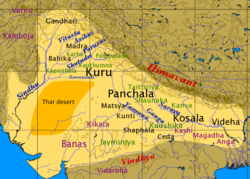

Early Vedic society consisted of largely pastoral groups, with late Harappan urbanization having been abandoned.[21] After the Rigveda, Aryan society became increasingly agricultural, and was socially organized around the four Varnas. In addition to the principal texts of Hinduism the Vedas, the core themes of the Sanskrit epics Ramayana and Mahabharata are said to have their ultimate origins during this period.[22] Early Indo-Aryan presence probably corresponds, in part, to the presence of Ochre Coloured Pottery in archaeological findings.[23]
The kingdom of the Kurus[24] corresponds to the Black and Red Ware and Painted Gray Ware culture and the beginning of the Iron Age in Northwestern India, around 1000 BCE with the composition of the Atharvaveda, the first Indian text to mention iron, as śyāma ayas, literally "black metal." The Painted Grey Ware culture spanning much of Northern India was prevalent from about 1100 to 600 BCE.[23] The Vedic Period also established republics (such as Vaishali) which existed as early as the sixth century BCE and persisted in some areas until the fourth century CE. The later part of this period corresponds with an increasing movement away from the prevalent tribal system towards establishment of kingdoms, called Maha Janapadas.

No comments:
Post a Comment